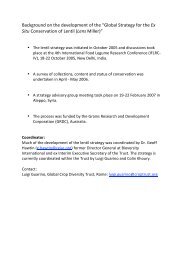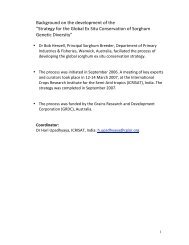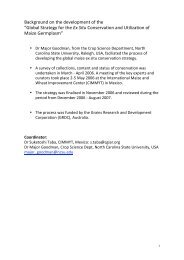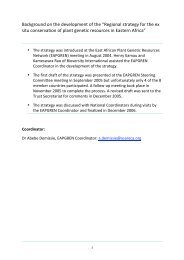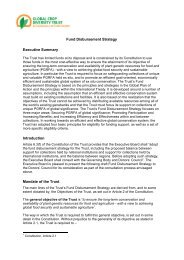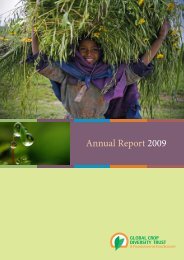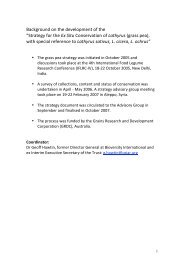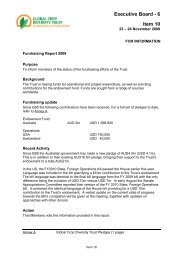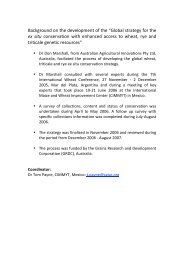Global Strategy for the Ex Situ Conservation of Potato - Global Crop ...
Global Strategy for the Ex Situ Conservation of Potato - Global Crop ...
Global Strategy for the Ex Situ Conservation of Potato - Global Crop ...
Create successful ePaper yourself
Turn your PDF publications into a flip-book with our unique Google optimized e-Paper software.
5.7.2 Needs and <strong>of</strong>fers <strong>for</strong> capacity building<br />
The 13 representatives <strong>of</strong> potato collections participating in <strong>the</strong> Lima workshop were<br />
requested to complete two <strong>for</strong>ms to inventory needs and <strong>of</strong>fers <strong>for</strong> capacity building. The<br />
results <strong>of</strong> this exercise are presented in Annex 6.<br />
Reported needs regarded eight major functions <strong>of</strong> potato genetic resources conservation<br />
and management. Streng<strong>the</strong>ning <strong>the</strong> capacity <strong>for</strong> regeneration, characterization and health<br />
screening appeared <strong>the</strong> most relevant needs. The genebanks <strong>of</strong> Latin America and Russia<br />
(VIR) required assistance in <strong>the</strong>se areas, a finding that agreed with <strong>the</strong> constraints<br />
mentioned in <strong>the</strong> questionnaire (see 5.6.1).<br />
The curators were also requested to list <strong>the</strong>ir potential <strong>of</strong>fers <strong>for</strong> <strong>the</strong>se same 10 functions.<br />
Several genebanks (see Annex 6b) were able to <strong>of</strong>fer assistance <strong>for</strong> safety duplication,<br />
germplasm distribution and training in PGR management. Documentation, regeneration and<br />
characterization were <strong>of</strong>fered by five organisations. The important need <strong>for</strong> health screening<br />
was only met by <strong>of</strong>fers from two institutions. In <strong>the</strong> past, CIP has trained young researchers<br />
in this field and it has knowledge and facilities <strong>for</strong> this activity.<br />
6. Components <strong>of</strong> <strong>the</strong> potato conservation strategy<br />
This chapter, although partly based on a set <strong>of</strong> recommendations adopted at <strong>the</strong> Lima<br />
workshop preparing <strong>for</strong> <strong>the</strong> global potato conservation strategy, presents <strong>the</strong> views <strong>of</strong> <strong>the</strong><br />
consultant.<br />
6.1 Status <strong>of</strong> potato genetic resources collections and current regeneration needs<br />
<strong>Potato</strong> is <strong>the</strong> fourth major crop in <strong>the</strong> world in terms <strong>of</strong> yield. This warrants substantial ef<strong>for</strong>ts<br />
<strong>for</strong> improvement <strong>of</strong> <strong>the</strong> crop and <strong>for</strong> conservation and utilization <strong>of</strong> potato genetic resources.<br />
The worldwide genepool <strong>of</strong> potato is maintained by approximately 30 major collections only.<br />
These collections are situated in <strong>the</strong> Andean centre <strong>of</strong> diversity <strong>of</strong> potato and outside <strong>the</strong><br />
Latin American region mainly in Europe, North America and a few countries in Asia (India,<br />
China and Japan). Annex 4 (Table 2) presents an overview <strong>of</strong> in<strong>for</strong>mation on 23 potato<br />
collections, <strong>for</strong> which <strong>the</strong> questionnaire was completed. In addition, in<strong>for</strong>mation on <strong>the</strong><br />
holdings <strong>of</strong> a few smaller European potato collections, obtained from <strong>the</strong> ECP/GR databases<br />
is included in Annex 5 (Tables 1, 3 and 4).<br />
A short overview <strong>of</strong> <strong>the</strong> composition <strong>of</strong> <strong>the</strong>se 23 collections is presented below. These<br />
collections comprise to a very large extent <strong>the</strong> potato germplasm on which a potato<br />
conservation strategy will need to focus.<br />
Wild relatives<br />
More than 17,500 accessions <strong>of</strong> wild relatives are maintained in 17 collections, but 85% <strong>of</strong><br />
<strong>the</strong>se accessions are conserved in seven genebanks only, including five genebanks outside<br />
<strong>the</strong> centre <strong>of</strong> diversity. These latter five genebanks conserve 72% <strong>of</strong> <strong>the</strong> total number <strong>of</strong> wild<br />
relatives. CIP maintains an additional number <strong>of</strong> 2,363 accessions <strong>of</strong> wild relatives (13%)<br />
and has <strong>the</strong> largest collection within Latin America. <strong>Conservation</strong> <strong>of</strong> wild relatives is well<br />
organized, although 3,600 accessions <strong>of</strong> wild species approximately need to be regenerated<br />
urgently.<br />
Native cultivars in <strong>the</strong> centre <strong>of</strong> diversity<br />
Similar figures apply to native cultivars. Seventeen collections contain more than 17,000<br />
accessions <strong>of</strong> native cultivars. Approximately 50 % <strong>of</strong> this material is vegetatively maintained<br />
in <strong>the</strong> centre <strong>of</strong> diversity in Latin America and 50% in collections situated in Europe, North<br />
18




